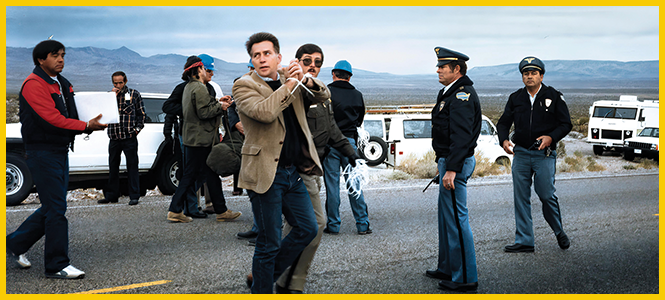Slamdance 2023 Downwind documentary preview
New documentary explores the legacy of nuclear testing on Southern Utah and beyond
By Scott Renshaw @scottrenshawIt's fairly common in the world of fiction filmmaking for one movie to be inspired by another. That idea may be less common for documentaries, but in a roundabout way, the Slamdance documentary Downwind might not exist if not for the 1956 Hollywood epic The Conqueror.
Downwind addresses the legacy of nuclear testing on the American West—including Southern Utah—and those whose lives were impacted by radioactive fallout, including some who became activists for the cause. According to the film's co-director Mark Shapiro, there was something particularly gripping about the story of The Conqueror, which was filmed in the St. George area in the year following several nuclear tests, and where dozens of cast and crew members—including stars John Wayne and Susan Hayward, and director Dick Powell—subsequently died of cancer.
"John Wayne in particular, he was sort of an iconic symbol of America," Shapiro says. "He was the all-American cowboy, yet this impacted him as well. [Co-director Douglas Brian Miller] had this idea of a lens metaphor, where we zoom in on St. George, then took the camera back so to speak, and through interviews."
Among those interview subjects was John Wayne's son, Patrick, who related an anecdote about the tons of red soil that was shipped from Utah to Hollywood to complete filming of The Conqueror on sound stages. "Patrick talks about going over to the studio in California with Geiger counters, and they were still getting readings, within the last 20 years," Shapiro says.
That story is just one example, of course, of the way fallout has had a lingering effect for decades, and Downwind explores a wide range of those impacts. Among the most significant are those affecting the Western Bands of the Shoshone Nation, whose ancestral lands in present-day Nevada were the site of the majority of testing. "[The site is] cordoned off and excluded from their heritage. There are petroglyphs, things on that land that are sacred," Shapiro says. "Ian Zabarte [Principal Man for the Western Bands of the Shoshone Nation] refers to the test site, and America, as the most bombed nation on Earth. He talks about water, how we are water, and the need for protecting water. When you contaminate it through testing, it goes somewhere."
As is true of most research projects, there were things the filmmakers knew that got them started, but things they learned along the way that shocked them. For Shapiro, among the most unsettling was how many tests took place, and for how long. "There were 928 detonations," he says. "A journalist in Las Vegas, Keith Rogers, gave me this book, U.S. Nuclear Tests, a pamphlet the details every test detonated at the Nevada test site. It's amazing when you leaf through this in black-and-white book: the purpose, the yield range, sometimes more than Hiroshima and Nagasaki combined. Most people are well aware of the first tests, but the fact that they had 928. ... That number is burned into my memory now."
The research and interviews for Downwind included many survivors and activists, including Utah journalist Mary Dickson, who has written extensively about being part of the "downwinders" community, as well as actor Martin Sheen. Those voices of activism became a key part of the movie, as Shapiro and Miller really began to understand the way that terrible circumstances often turn people into reluctant activists.
"We were inspired by the idea that they had decided to change the world," Shapiro says. "That's why we felt the people in our film aren't just reluctant activists; they're inspirational activists. A lot of them know each other, have met at conferences, or through Zoom. But they all have this thing that happened to them, and continues to happen to them. And they are non-stop. They speak their mind."
Amplifying the voice of those who have decided to speak their mind is part of the mission of Downwind, yet it's also a way of re-thinking what it means to be quintessentially "all-American," and not just in the way associated with an iconic figure like John Wayne. "I'm so proud to be an American, but I think it's important to take our country to task at times," Shapiro says. "I wonder about the number of tests that were conducted, and the fact that it's not really taught in schools.
"Martin Sheen, for example, he loves this country, but it doesn't mean you can't take it to task. 'Patriot' and 'activist' both have negative connotations now, but there are patriots who are progressive and want to see change. ... There's a lot going on in the world, a lot of challenges. It's important that we all take a pause and recognize that part of being an American is speaking out and speaking your mind."
Downwind premieres at Slamdance Film Festival on Monday, Jan. 23, including a panel discussion. Visit slamdance.com/festival/ for more information.
More by Scott Renshaw
-
Film Reviews: New Releases for April 19
The Ministry of Ungentlemanly Warfare, Abigail, The Beast, Hard Miles, Sasquatch Sunset and more
- Apr 19, 2024
-
Faces of Salt Lake County book and portrait reception
Images and personal stories in a new book reveal local demographic diversity
- Apr 17, 2024
-
Feature film review: THE BEAST
A filmmaker's compelling ideas get a bit tangled in references to his creative influences.
- Apr 17, 2024
- More »
Latest in Cover Story
Readers also liked…
-
Forget the family pedigree—Robert F. Kennedy Jr should not be the next president of the United States
Trojan Horse
- Jun 21, 2023
-
Women decry harassment and toxic culture at St. George auto dealership
Men at Work
- Oct 11, 2023





